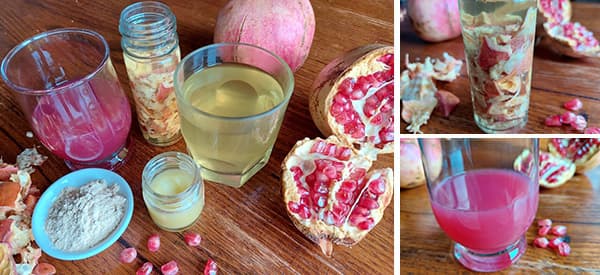
8 Surprising Ways to Use Pomegranate to Heal From Inside Out
Pomegranates (Punica granatum) are one of my favorite fruits to grow; they thrive on neglect even in the toughest conditions – from extreme heat to freezing cold. Once established, they are heavy producers of fruit which can withstand hail storms thanks to their tough peel and they have good disease resistance which means no spraying and minimal care.
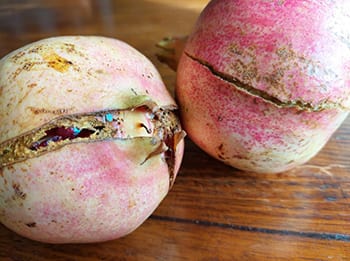 Pomegranates are usually harvested in late summer to autumn, depending on the region. You know they are ripe when you see obvious lines and cracks forming on the peel. I find the ripest fruits are the ones that have already cracked completely open like in the photo.
Pomegranates are usually harvested in late summer to autumn, depending on the region. You know they are ripe when you see obvious lines and cracks forming on the peel. I find the ripest fruits are the ones that have already cracked completely open like in the photo.
There are so many reasons to grow pomegranates and even more reasons to eat or use them for their health benefits!
7 Major Health Benefits of Pomegranate
Anti-fungal
Every part of the fruit can be used topically as an anti-fungal, especially against drug-resistant candida strains. In fact, many studies show pomegranate extracts to be far superior to many prescribed anti-fungal drugs. Squeeze out the juice and dry the seeds with their remaining pulp. Once thoroughly dry, grind them into a fine powder. This powder can be incorporated into a number of products to increase their anti-fungal powers.
Anti-bacterial
Pomegranate juice is a powerful anti-bacterial and anti-microbial which is one reason why it makes a good wound healer.
Anti-Ulcerative and Gut Flora- Restoring
Pomegranate peels are a strong anti-oxidant and anti-ulcerative thanks to their high level of phenolics. Best extracted into an alcoholic tincture.
Fresh pomegranate fruit is also incredibly high in antioxidants, anti-inflammatories, and anti-peroxidation compounds. They are also high in ellagic acid which reduces gastrointestinal inflammation due to changes in your gut flora.
Anti-Depressant and Anti-Anxiety
Although the research is limited, initial findings show that drinking pomegranate juice may be suitable for treating anxiety and depression, perhaps by changing the concentration of certain amino acids and serotonin in the brain.
Reducing The Risk of Heart Disease
The membrane (or mesocarp) surrounding each fruit is thought to have a cardioprotective effect. Pomegranate juice also decreases cholesterol, triglycerides and blood pressure.
Treating Diabetes and Obesity
Pomegranate products have been shown to improve insulin sensitivity, regulate blood glucose levels and modulate insulin production and secretion.
Pomegranate peel anthocyanins may be responsible for the anti-obesity claims. These compounds are water soluble so a strong cup of pomegranate peel tea every day can be a complimentary treatment for obesity.
Anti-cancer
A large variety of cancers are inhibited by pomegranate juice, pomegranate peel tincture or pomegranate seed oil. Interestingly, the efficacy of pomegranate products against cancer depends on which genotype you are.
8 Surprising Ways to Use Pomegranate
So, to sum up, there are at least 8 different ways to use pomegranate, each producing a number of benefits for your health, both inside and out.
Whole Fruit: Eating the whole fruit on a regular basis will encourage good gut flora and increase anti-oxidant and anti-inflammatories in your blood. Whole fruit may also provide a cardioprotective effect as well as help to treat diabetes and obesity. Eat 7 oz (200 g) per day for 3 months.
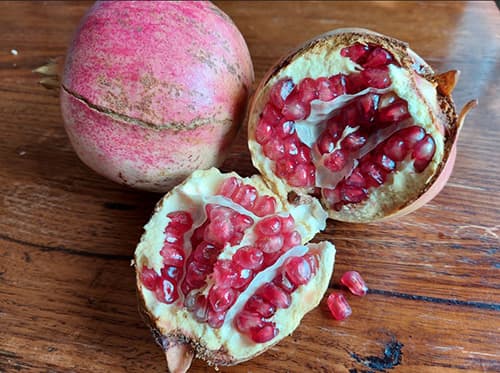
Pomegranate Juice: 750 ml/week is the recommended dose to reduce the risk of cancers, treat diabetes, decrease cholesterol, lower blood pressure, control depression or anxiety, reduce gastrointestinal inflammation and promote good gut flora. Topically applying the juice can disinfect bacterial and fungal wounds.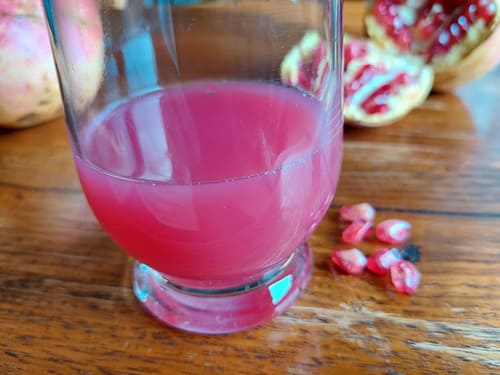
Pomegranate Peel Tincture: Soaking the peels in high proof alcohol for 1 – 2 weeks produces an oral treatment for stomach ulcers and various types of cancer. If you have 90% alcohol, then fresh peels can be used, but if you only have 40% alcohol, then it’s best to chop up and dry the peels before soaking them for 1 – 2 weeks. Take about 1 dropper (1.5 ml) per day.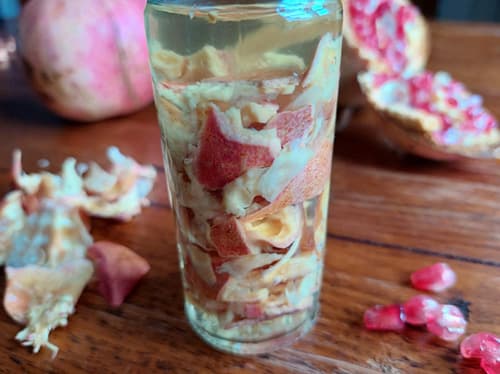
Pomegranate Peel Tea: A strong cup of pomegranate peel tea everyday may assist with managing obesity and diabetes.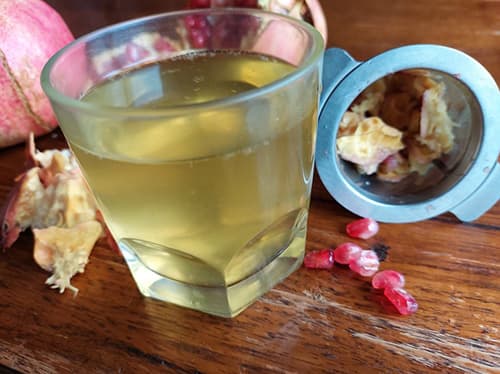
Powdered Pomegranate Fruit: The easiest way to store pomegranates over the long-term, simply strain out the juice then dry the seeds and pulp. Grind them into a fine powder using an electric grinder. This powder can be incorporated into oil, a salve, a tincture or soap to treat fungal and bacterial infections as well as general wounds.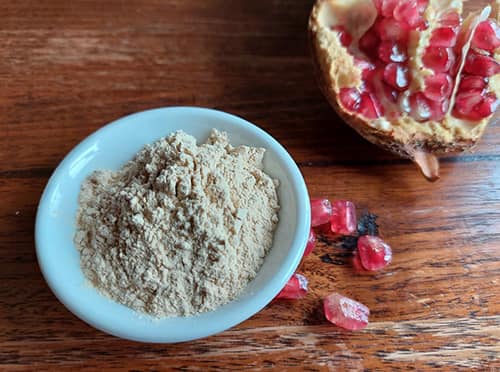
Pomegranate Salve: Once you make some pomegranate powder, you can add this directly to any moisturizer you have at home, otherwise infuse the powder in warm oil for 2 – 3 hours, decant the mix and use the oil to make a salve by adding a small amount of beeswax to the oil over a double-boiler. Note: Last year, I tried washing and drying the whole seeds to infuse in oil, but the membrane on the seeds still retained enough moisture to contaminate my infused oil with water. A BIG no-no for oil-based products! Therefore, I recommend drying and grinding up the seeds to ensure they are completely moisture-free.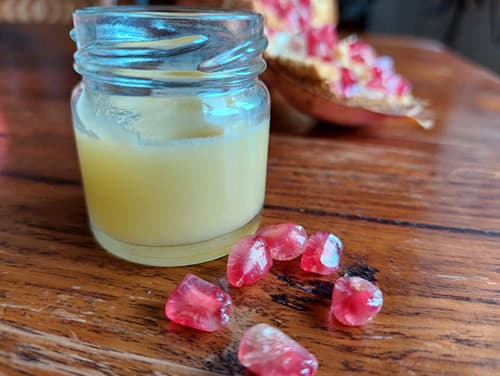
Pomegranate Soap: If you are using melt-&-pour soap, then add powdered pomegranate. If you are making hot/cold processed soap, then simply dry the seeds and add them as an exfoliator, anti-fungal and anti-bacterial agent.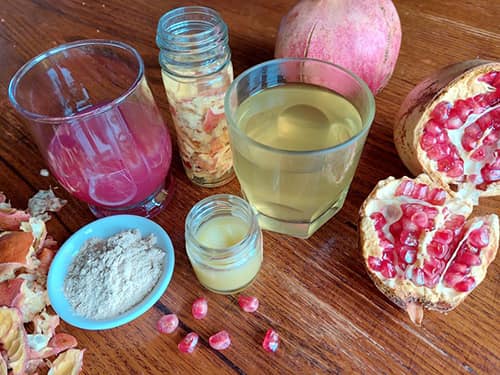
Pomegranate Seed Oil: Not something for the average backyard producer, but it’s definitely possible to purchase pomegranate seed oil online. When ingested, the oil from the pomegranate seed can help to reduce the risk of some types of cancer.
Sweet and succulent, hardy and healthy; Pomegranates provide a diverse variety of health benefits and these 8 different methods range from the convenience of drinking some pomegranate juice or peel tea, to creating a tincture or salve for use throughout the year.
You may also like:
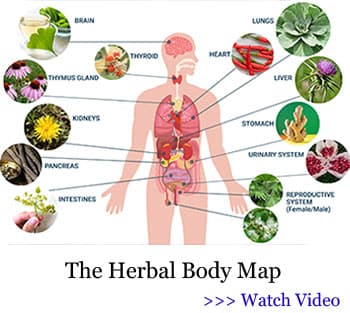 20 Toxic Ingredients to Avoid in Your Beauty Products
20 Toxic Ingredients to Avoid in Your Beauty Products
The 10 Plants That Should Be In Your First Aid Kit (Video)

It might help some people (like me) if you explain how to extract the juice from a pomegranate, as well as how you ordinarily eat a pomegranate. Thank you.
I have a juicer specifically for this purpose however I love in Italy and purchased it here as I have many pomegranate trees. Not sure if you can buy this elsewhere sorry
You have a POMEGRANATE juicer, or just a juicer? What brand?
We had a pomegranate tree at our grade school. We used to suck on the seeds to get the juice then spit them out. I don’t know if that’s the proper way to eat them.
The seeds are good to eat. I don’t spit them out
You juice only the seeds:
Put the seeds in the blender and pulse them slightly. Do not blend them for long, or they completely break apart and form a cloudy juice. Pulsing only breaks them apart sufficiently for the juice to come out.
Once you are sure they have broken, and the juice is flowing, remove them from the blender and place them in a strainer. It is best to use a metal strainer to avoid staining plastic strainers.
Using a spoon, keep pressing the blended pulp to release the juice from the pomegranate seeds. Try and extract as much liquid as possible.
If you find many whole seeds that haven’t been broken down, you can place them back into the blender and pulse them again to break them open. Repeat the straining process to get more juice.
Thank you for that explanation! I’m 61 years old and have always wanted that explanation but when I could Google it, I’d already forgotten the thought! So thank you!!
Awesome clear instructive advice! Thank you!
I learned from my middle eastern friend a easy way to enjoy the pomagante juice
is to press the skin of the pomegranate with your two thumbs you will notice the
skin will get soft as you are actually pressing the seeds(crushing) and releasing the
juice when you have crushed the skin till it appears softened then bite a small hole
in the skin and place your lips to that hole and begin drawing the juice from the
pomagrante. Then you can open the fruit and extract all the seeds that still contain
the juice, chewing them ,digesting them or discarding the empty seeds into the trash
I bought a nice hand juicer from Amazon that does pomegranates and oranges, grapefruit, etc. It is a nice heavy duty one:
https://www.amazon.com/Mueller-Manual-Citrus-Juicer-Squeezer/dp/B08R993YJK/ref=sr_1_3?70b6bc
PS: Don’t buy LARGE pomegranates. They won’t squeeze all of the juice out of the outer arils. Get smaller ones.
Nicole, the dose for the juice is 750 ml ? I wouldn’t think that is per day but maybe it is?
BTW, love your posts!
Hi Paula,
We apologize for the confusion. The recommended dose of pomegranate juice is 750 ml/week. We updated the article as well.
Thank you for your continuous support.
Many blessings and good health!
It’s 750mls a week.
I am a pomegranate eater. It would be nice if the information would be provided or available in a pamphlet or book form for us to have readily available at home. Great information.
Hello John,
Thank you so much for your interest in herbal remedies!
You should check out Nicole’s books, The Lost Book of Herbal Remedies and The Forager’s Guide to Wild Foods. You can find both in our Store section. If you need help with your purchase, don’t hesitate to contact us at support@thelostherbs.com.
The Lost Book of Herbal Remedies provides a well-organized guide to medicinal plants. It has instructions on how to identify and harvest plants, how to make teas, decoctions, oil infusions, salves, tinctures and more.
For each plant in the book, you’ll find a thorough description on its edible and medicinal use.
The Forager’s Guide to Wild Foods will help you and your loved ones take advantage of the wild foods near your home and have constant access to healthy meals. It depicts 400 wild foods, has plant localization maps for each plant (400 maps), with superior plant identification guidelines and food recipes for each plant, full page photos of the plants, (at least 3 color pictures for each).
Many blessings and good health!
We tried growing them (zone 9B/10A and 3 miles from the ocean) – the plants survived and bloomed, but didn’t fruit after 8 years… Don’t know if it was the heat or residual salt in the air.
Three cups of juice a day seems like a lot
Information is interesting. I’ll try some of the pomegranate suggestions. I am a pomegranate eater.
I bought your digital book. When m.y computer crashed, I lost it. Can you help, or should I buy your paper book
Thank you so very much for this informative article…I never knew all of this and because I live with some of these issues, I’ll go today and find pomegranates at my fruit and veg store! Blessings!